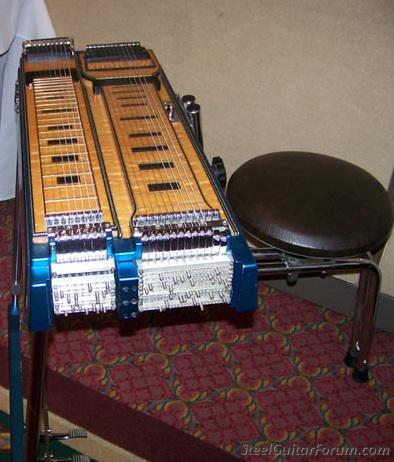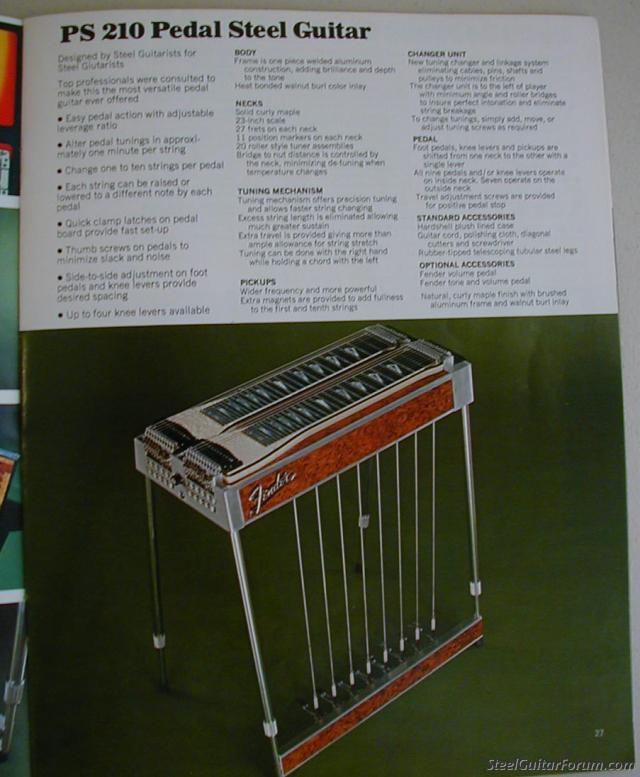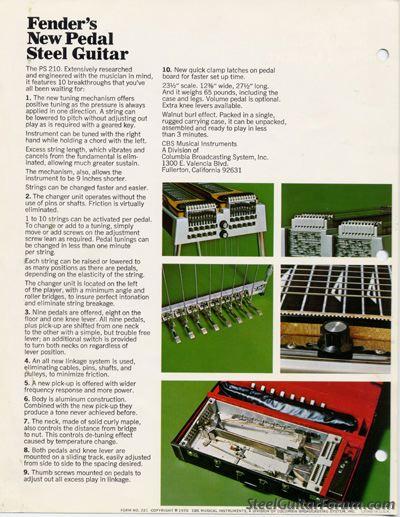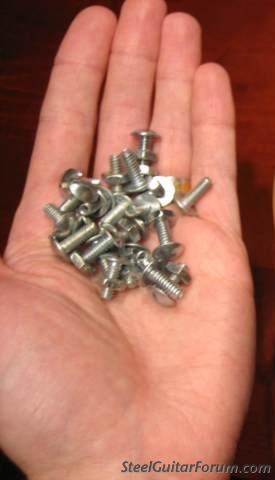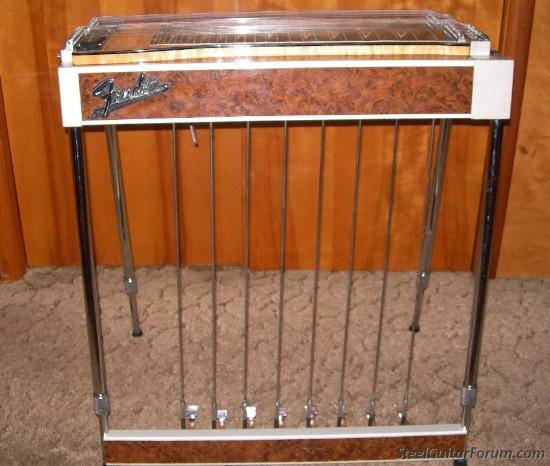Fender PS210
Moderator: Dave Mudgett
-
Bob Adams
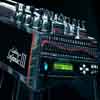
- Posts: 384
- Joined: 25 Dec 2007 2:37 pm
- Location: Scotland, UK
Fender PS210
For any of you who haven't seen one of these in a while! I thought I should post! I think it is the biz!
Your input is much appreciated,
http://www.pedalsteel.co.uk/Vintage-Fender-PS210
Sincere thanks, Bob
Your input is much appreciated,
http://www.pedalsteel.co.uk/Vintage-Fender-PS210
Sincere thanks, Bob
Last edited by Bob Adams on 5 Feb 2010 4:46 pm, edited 5 times in total.
-
Skip Edwards
- Posts: 3080
- Joined: 1 Dec 1998 1:01 am
- Location: LA,CA
-
Kevin Hatton
- Posts: 8229
- Joined: 3 Jan 2002 1:01 am
- Location: Buffalo, N.Y.
-
Roger Shackelton
- Posts: 3911
- Joined: 18 Mar 1999 1:01 am
- Location: MINNESOTA (deceased)
Fender Steel Guitar
HI BOB,
These photos are of a "FENDER PS-210", built around 1970.
I believe GENE FIELDS designed the FENDER PS-210.
A FENDER 2000 is a D-10 PSG, which are cable operated guitars. They were normally painted in a
"SUNBURST" finish.
ROGER
These photos are of a "FENDER PS-210", built around 1970.
I believe GENE FIELDS designed the FENDER PS-210.
A FENDER 2000 is a D-10 PSG, which are cable operated guitars. They were normally painted in a
"SUNBURST" finish.
ROGER
-
Ben Jones

- Posts: 3356
- Joined: 12 Dec 2005 1:01 am
- Location: Seattle, Washington, USA
-
Skip Edwards
- Posts: 3080
- Joined: 1 Dec 1998 1:01 am
- Location: LA,CA
-
Bob Adams

- Posts: 384
- Joined: 25 Dec 2007 2:37 pm
- Location: Scotland, UK
-
Allan Munro

- Posts: 1046
- Joined: 10 Aug 2009 8:41 pm
- Location: Pennsylvania, USA and Scotland
-
Skip Edwards
- Posts: 3080
- Joined: 1 Dec 1998 1:01 am
- Location: LA,CA
-
Nicholai Steindler
- Posts: 247
- Joined: 20 Dec 2009 4:38 pm
- Location: New York, USA
-
Russ Wever
- Posts: 2674
- Joined: 16 Dec 1998 1:01 am
- Location: Kansas City
-
basilh

- Posts: 7709
- Joined: 26 May 1999 12:01 am
- Location: United Kingdom
After tonight's gig I'll record a short video and post it, AND maybe I'll point out how the mechanism works..
Just imagine being able to reconfigure from ABC (Emmons) to CBA (Day) in about 3 minutes, AND the capability of changing the pedal and knee lever spacing and positions in a similar timespan..
Out of the 14 that were made I know of only a few (6) that are still accounted for, and I'm not sure but I know that mine is probably the only one being played in public weekly (VERY WEAKLY)
How about a register of known owners.
Just imagine being able to reconfigure from ABC (Emmons) to CBA (Day) in about 3 minutes, AND the capability of changing the pedal and knee lever spacing and positions in a similar timespan..
Out of the 14 that were made I know of only a few (6) that are still accounted for, and I'm not sure but I know that mine is probably the only one being played in public weekly (VERY WEAKLY)
How about a register of known owners.
-
richard burton

- Posts: 3854
- Joined: 23 Jan 2001 1:01 am
- Location: Britain
-
Alan Brookes

- Posts: 13227
- Joined: 29 Mar 2006 1:01 am
- Location: Brummy living in Southern California
Three years ago Basil demonstrated this to me. I told him what copedant I wanted and he changed it to what I said within a lot less time than 3 minutes.basilh wrote:...Just imagine being able to reconfigure from ABC (Emmons) to CBA (Day) in about 3 minutes, AND the capability of changing the pedal and knee lever spacing and positions in a similar timespan...
I've always thought that one of the main failings of steel guitar design is having to turn the instruments over to change the copedant. Another instrument you can change quickly is the Harlin MultiKord, but it's not so advanced as this Fender, nor would you expect it to be as it was produced many years beforehand.
-
Roger Shackelton
- Posts: 3911
- Joined: 18 Mar 1999 1:01 am
- Location: MINNESOTA (deceased)
Fender Ps-210
In the early 1970s when the FENDER PS-210 was manufactured, it was a very radical change in steel guitar technology.
Too bad only 15 were produced.
ROGER
Too bad only 15 were produced.
ROGER
-
Bob Estes
- Posts: 29
- Joined: 6 Mar 2007 2:17 pm
- Location: Harrison,Arkansas, USA
-
Scott Howard

- Posts: 702
- Joined: 6 Jul 2001 12:01 am
- Location: Georgetown, TN, USA
Why did no one else ever pick up on the design and produce something close. It looks like a good idea to me and I see several things I like about it. I remember seeing it in a Fender catalog when I was starting out.
Last edited by Scott Howard on 6 Feb 2010 7:22 pm, edited 1 time in total.
"The Oddball" A MSA Keyless with pedals to the right.
-
Danny James
- Posts: 694
- Joined: 3 May 2004 12:01 am
- Location: Summerfield Florida USA
Many thanks to Russ Wever above, who gave us a place to click and see the article on Gene Fields, the designer of the Fender PS-210 In it is given a tremendous amount of information about the construction of the changer. It is interesting in that it includes in part 2, --- " The changer was operated by set screw bars similar to the multi-kord."
Gene's design of the changer itself was no doubt an improvement. The way the pedals and knee levers were tuned according to the article, was similar to Jay Harlin's of the Harlin Bros. original design and patent. It is well known that Jay was the inventor of the Multi-Kord and the first to hold a patent on a pedal steel guitar.
It seems the Fender PS-210 had some features that would be most desirable if they were incorporated on the modern pedal steel guitars being built today.
I have found out recently that Jay Harlin had some other designs he was working on. There was talk of a lawsuit concerning patent infringement is the reason the Electra Harp by Gibson was discontinued.
Gene's design of the changer itself was no doubt an improvement. The way the pedals and knee levers were tuned according to the article, was similar to Jay Harlin's of the Harlin Bros. original design and patent. It is well known that Jay was the inventor of the Multi-Kord and the first to hold a patent on a pedal steel guitar.
It seems the Fender PS-210 had some features that would be most desirable if they were incorporated on the modern pedal steel guitars being built today.
I have found out recently that Jay Harlin had some other designs he was working on. There was talk of a lawsuit concerning patent infringement is the reason the Electra Harp by Gibson was discontinued.
-
Eric Stumpf

- Posts: 520
- Joined: 9 Jul 1999 12:01 am
- Location: Newbury, NH 03255
Sometime last year a PS210 was for sale somewhere (was it here, or eBay? I don't recall) that had been one of Gene Field's personal guitars. It had one neck that was fretted so that it could be played ala Thumbs Carlisle style. The Fields guitar pictured in this thread also apparently has a fretted outer neck. This wasn't a standard feature of these guitars but really, does it get much cooler than that?
-
Jay Jessup

- Posts: 952
- Joined: 12 Jan 1999 1:01 am
- Location: Charlottesville, VA, USA
Billy Cooper has more cool stuff than most of us have ever seen hanging on the wall of his steel guitar showroom in Orange Va as decorations, one of them is a PS210.basilh wrote: Out of the 14 that were made I know of only a few (6) that are still accounted for,
How about a register of known owners.
-
Paul Redmond
- Posts: 1167
- Joined: 3 Apr 2006 12:01 am
- Location: Illinois, USA
On Gene's personal guitar, yes, the front neck is fretted, has eight strings, and is played "Thumbs-style". His rear neck has 12 strings and is tuned either to a D6th or G6th...I forget now.
The thing I find most amazing about these guitars is the shift mechanism which moves all the pulling linkage from one neck to the other, also switching one pickup on and the other off. There is an over-ride switch underneath if both pickups are to be on at the same time.
On the guitar I have (#11), the pull travel can be stopped either at the drawbars on the endplate, or via a strong metal stamping containing #8-32 adjustment screws. The latter allows all the drawbars on the changer to then "float" rather than bottom out.
The various components in the pulling linkage have a large number of holes which allows for an almost unlimited number of leverage/travel settings on each pull. The short pullrods, according to Gene, were made of re-threaded bicycle spokes which are threaded into round sleeves for length adjustment. In short, the guitars are almost limitless in adjustment capabilities.
IMO these guitars would still be very viable today more than four decades after they were first conceived. Despite their diminutive overall size, the little buggers are pretty heavy, but I'm confident that with some changes in design, the weight issue could be overcome.
The changer itself is awesome in design with one cast finger riding "knife-edge" inside the other, then the assembly itself riding on a knife edge plate on the body...zero friction!!!
The pedal rack is held to the front legs with an underwater camera enclosure locking device containing a cam-type lock. These locks are mounted on their own hinges...just twist the cam loose and rotate the "hook" out of the way for rack removal. Adjustment of the pedal rod length is made easy using some sort of commercially-available, spring-loaded connector which then couples onto a lathe-turned nylon sleeve screwed to the side of each pedal. If you want to change the rod length, you just uncouple the swivel and screw it in or out to alter the rod length, then re-couple it...no wrenches needed.
AND it DOES sound like a Fender!!!
PRR
The thing I find most amazing about these guitars is the shift mechanism which moves all the pulling linkage from one neck to the other, also switching one pickup on and the other off. There is an over-ride switch underneath if both pickups are to be on at the same time.
On the guitar I have (#11), the pull travel can be stopped either at the drawbars on the endplate, or via a strong metal stamping containing #8-32 adjustment screws. The latter allows all the drawbars on the changer to then "float" rather than bottom out.
The various components in the pulling linkage have a large number of holes which allows for an almost unlimited number of leverage/travel settings on each pull. The short pullrods, according to Gene, were made of re-threaded bicycle spokes which are threaded into round sleeves for length adjustment. In short, the guitars are almost limitless in adjustment capabilities.
IMO these guitars would still be very viable today more than four decades after they were first conceived. Despite their diminutive overall size, the little buggers are pretty heavy, but I'm confident that with some changes in design, the weight issue could be overcome.
The changer itself is awesome in design with one cast finger riding "knife-edge" inside the other, then the assembly itself riding on a knife edge plate on the body...zero friction!!!
The pedal rack is held to the front legs with an underwater camera enclosure locking device containing a cam-type lock. These locks are mounted on their own hinges...just twist the cam loose and rotate the "hook" out of the way for rack removal. Adjustment of the pedal rod length is made easy using some sort of commercially-available, spring-loaded connector which then couples onto a lathe-turned nylon sleeve screwed to the side of each pedal. If you want to change the rod length, you just uncouple the swivel and screw it in or out to alter the rod length, then re-couple it...no wrenches needed.
AND it DOES sound like a Fender!!!
PRR
-
Jody Sanders
- Posts: 7055
- Joined: 12 Apr 2000 12:01 am
- Location: Magnolia,Texas, R.I.P.
-
Ben Jones

- Posts: 3356
- Joined: 12 Dec 2005 1:01 am
- Location: Seattle, Washington, USA
-
Danny James
- Posts: 694
- Joined: 3 May 2004 12:01 am
- Location: Summerfield Florida USA



